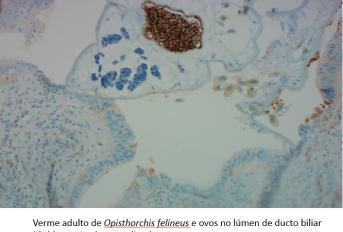Associação Portuguesa de Investigação em Cancro
Infection with Opisthorchis felineus induces intraepithelial neoplasia of the biliary tract in a rodent model
Infection with Opisthorchis felineus induces intraepithelial neoplasia of the biliary tract in a rodent model

Authors and Affiliations:
Gouveia MJ1,2, Pakharukova MY3,4, Laha T5,6,7, Sripa B5,6,7, Maksimova GA3, Rinaldi G8, Brindley PJ8, Mordvinov VA3,9, Amaro T10, Santos LL10, Costa JMCD1,11, Vale N2,12.
1 Center for the Study in Animal Science, ICETA, University of Porto, Rua de D. Manuel II, Apt 55142, 4051-401 Porto, Portugal.
2 UCBIO/REQUIMTE, Department of Chemistry and Biochemistry, Faculty of Sciences, University of Porto, Rua do Campo Alegre 687, 4169-007 Porto, Portugal.
3 Laboratory of Molecular Mechanisms of Pathological Processes, Institute of Cytology and Genetics, Siberian Branch of the Russian Academy of Sciences, 10 Lavrentiev Avenue, 630090 Novosibirsk, Russia.
4 Novosibirsk State University, 2 Pirogov Street, 630090 Novosibirsk, Russia.
5 Department of Parasitology.
6 Department of Pathology.
7 Tropical Diseases Research Laboratory, Faculty of Medicine, Khon Kaen University, Khon Kaen, Thailand.
8 Department of Microbiology, Immunology & Tropical Medicine, Research Center for Neglected Diseases of Poverty, School of Medicine & Health Sciences, George Washington University, Washington, DC 20037, USA.
9 Laboratory of Drug Metabolism and Pharmacokinetics, Institute of Molecular Biology and Biophysics, 2/12 Tymakov Street, 630055 Novosibirsk, Russia.
10 Experimental Pathology and Therapeutics Group, Research Center of Instituto Português de Oncologia, Rua Dr. António de Almeida 4200-072 Porto, Portugal.
11 Centre for Parasite Immunology and Biology, Infectious Diseases Department, INSA, Rua Alexandre Herculano 321, 4000-055 Porto, Portugal.
12 Laboratory of Pharmacology, Department of Drug Sciences, Faculty of Pharmacy, University of Porto, Rua Jorge Viterbo Ferreira, 228, 4050-313, Porto, Portugal.
Abstract:
The liver fluke Opisthorchis felineus is a member of the triad of epidemiologically relevant species of the trematode family Opisthorchiidae, and the causative agent of opisthorchiasis felinea over an extensive range that spans regions of Eurasia. The International Agency for Research on Cancer classifies the infection with the liver flukes Opisthorchis viverrini and Clonorchis sinensis as group 1 agents and a major risk factor for cholangiocarcinoma. However, the carcinogenic potential of the infection with O. felineus is less clear. Here, we present findings that support the inclusion of O. felineus in the Group 1 list of biological carcinogens. Two discrete lines of evidence support the notion that infection with this liver fluke is carcinogenic. First, novel oxysterol-like metabolites detected by liquid chromatography-mass spectroscopy in the egg and adult developmental stages of O. felineus, and in bile, sera, and urine of liver fluke-infected hamsters exhibited marked similarity to oxysterol-like molecules known from O. viverrini. Numerous oxysterols and related DNA-adducts detected in the liver fluke eggs and in bile from infected hamsters suggested that infection-associated oxysterols induced chromosomal lesions in host cells. Second, histological analysis of liver sections from hamsters infected with O. felineus confirmed portal area enlargement, inflammation with severe periductal fibrosis and changes in the epithelium of the biliary tract characterized as biliary intraepithelial neoplasia, BilIN. The consonance of these biochemical and histopathological changes revealed that O. felineus infection in this rodent model induced precancerous lesions conducive to malignancy.
Journal: Carcinogenesis
Link: https://academic.oup.com/carcin/article-lookup/doi/10.1093/carcin/bgx042




